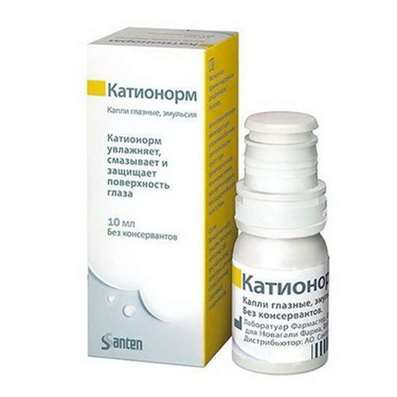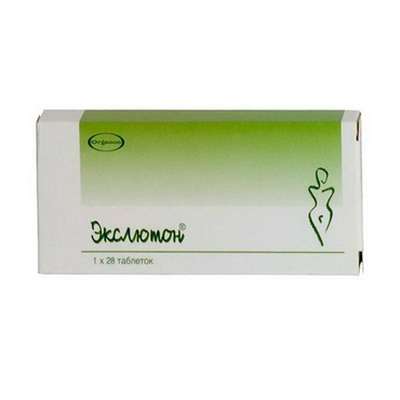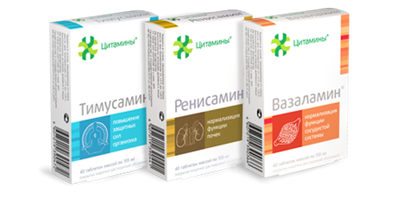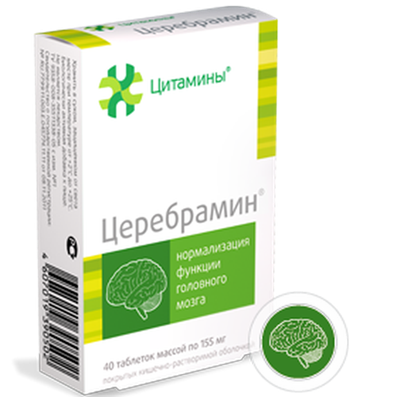Cytoflavin tablets - Instructions for Use, Dosage, Side Effects
13 Jan 2017
Pharmacological group: metabolic means
Trade name: TSITOFLAVIN (CYTOFLAVIN),Cytoflavin
Cytoflavin is a metabolic agent. All Cytoflavin ingredients are natural body metabolites and stimulate tissue respiration.
Synonyms: Cerebronorm.
Active substance: Inosine, Nicotinamide, Riboflavin, Succinic Acid.
Grouping name: Inosine + + Riboflavin Nicotinamide + Succinic acid
Dosage form: enteric coated tablets
Composition per 1 tablet:
active substance:
succinic acid - 0.300 g, inosine (Riboxinum) - 0.050 g nicotinamide - 0.025 g
riboflavin sodium phosphate (riboflavin) - 0.005 g;
Excipients:
povidone - 0.00810 g, calcium stearate - 0.00390 g
Hypromellose - 0.00360 g polysorbate 80 - 0.00040 g;
enteric coat: methacrylic acid and ethyl acrylate copolymer - 0.02902 g propylene glycol - 0.00291 g dye azorubin (karmuazin) (E 122) - 0.00007 g
Cytoflavin tablets 400 mg, N50
Cytoflavin tablets 400 mg, N100
Therapeuctic category:
metabolic regulator.
Nosological classification (ICD–10)
I67.2 Cerebral atherosclerosis;
I67.4 Hypertensive encephalopathy;
I67.9 Cerebrovascular disease, unspecified;
I69.3 The consequences of cerebral infarction;
R53 Malaise and fatigue.
Pharmacological properties
Cytoflavin possesses anti-hypoxic activity, stimulating energy production in the cells; reduces free radical generation, and restores antioxidant enzyme activities.
The medicine improves cerebral blood flow; activates metabolic processes in central nervous system, and has positive effect on bioelectrical activity of the brain. You can also like Pinealon.
Cytoflavin has beneficial effect on patient’s neurologic status by reducing the manifestations of asthenia, headache, vestibulocerebellar and cochlear-vestibular syndromes. It also eliminates the distress in emotional and volitive sphere of the patient by reducing anxiety and depression; improves intellectual and mental function and quality of patient’s life.
pharmacological properties
pharmacodynamics
Pharmacological effects are caused by the combined action of a part of the drug cytoflavin components.
Succinic acid (UC) - the endogenous intracellular metabolite of the Krebs cycle, performing a universal energy-synthesizing function in the cells of the body. With the participation of the coenzyme flavin adenine dinucleotide (FAD) succinic acid mitochondrial enzyme succinate dehydrogenase rapidly transformed into fumaric acid, and later in other metabolites of the citric acid cycle. It stimulates aerobic glycolysis and ATP synthesis in cells.
The final product of succinic acid metabolism in the Krebs cycle is carbon dioxide and water. Succinic acid improves tissue respiration due to electron transport activation in mitochondria.
Riboflavin (vitamin B2) is a flavin cofactor (FAD), activating suktsinad dehydrogenase and other redox reactions of the Krebs cycle. Nicotinamide (Vitamin PP) nicotinamide.
Nicotinamide in cells via a cascade of biochemical reactions, transformed into a form of nicotinamide adenine nucleotide (NAD) and its phosphate (NADP), nicotinamide-dependent activating enzymes Krebs cycle required for stimulation of cellular respiration and ATP synthesis.
Inosine is a purine derivative, a precursor of ATP. It has the ability to activate a number of enzymes of the Krebs cycle by stimulating the synthesis of key enzymes, nucleotides: flavin adenine dinucleotide (FAD) and nicotinamide adenine dinucleotide (NAD).
Thus, all components are natural metabolites Cytoflavin body and stimulate tissue respiration. Metabolic energy-correction antihypoxic and antioxidant activity of the drug, which determine the pharmacological properties and therapeutic efficacy of the components, due to the complementary action of succinic acid, inosine, nicotinamide and riboflavin.
Pharmacokinetics
Citoflavin has high bioavailability.
Succinic acid ingestion penetrates from the gastrointestinal tract into the blood and tissue reactions taking part in energy metabolism and is completely degraded to end products of metabolism (carbon dioxide and water) after 30 minutes.
Inosine is well absorbed from the gastrointestinal tract. The time to reach maximum blood concentration - 5 hours average residence time in the blood - 5.5 hours, the equilibrium distribution of volume of about 20 liters. Inosine is metabolized in the liver to form inosine monophosphate, followed by its oxidation to uric acid. In small quantities excreted by the kidneys.
Nicotinamide is rapidly distributed in all tissues (the equilibrium volume of distribution of approximately 500 liters). The time to reach maximum blood concentration - 2 hours, the average retention time in the blood - 4.5 hours. Nicotinamide crosses the placenta and breast milk; metabolized in the liver with the formation of N-methylnicotinamide, excreted by the kidneys.
Riboflavin is rapidly absorbed from the gastrointestinal tract, unevenly distributed (the highest number in the myocardium, liver, kidney), is transformed into flavinadeninmononukleotid (FMN) and flavin adenine dinucleotide (FAD) in the mitochondria. It penetrates through the placenta and breast milk; excreted by the kidneys, mainly as metabolites.
Indications for Cytoflavin
In adults in the treatment of:
- The consequences of cerebral infarction;
- Other cerebrovascular diseases (cerebral atherosclerosis, hypertensive encephalopathy);
- Neurasthenia (irritability, fatigue, loss of the ability to long-term mental and physical stress).
Cytoflavin Dosage and Administration
Inside of 2 tablets 2 times a day with an interval between receptions of 8-10 hours. Tablets should be taken at least 30 minutes before a meal, without chewing, washing down with water (100 ml).
It is recommended taking the drug in the morning and day time (within 18 hours).
The duration of treatment of 25 days. Purpose of the course may repeat at intervals of not less than 1 month.
Cytoflavin Side effect
Headache, pain or discomfort in the epigastric region. Allergic reactions such as skin redness and itching. Adverse reactions include: transient hypoglycemia, hyperuricemia, gout exacerbation of concomitant.
If any of these instructions side effects are compounded or you notice any other side effects not mentioned in the instructions, inform your doctor.
Overdose
So far, cases of drug overdose cytoflavin has not been established.
Cytoflavin Interaction with other drugs
Succinic acid, inosine and nicotinamide, are part of the drug Citoflavin compatible with other drugs.
Riboflavin, which is part of the drug Citoflavin, reduces the activity of some antibiotics (tetracyclines, erythromycin, lincomycin), is incompatible with streptomycin. Ethanol, three cyclic antidepressants, tubular secretion blockers reduce the absorption of riboflavin and thyroid hormones accelerate its metabolism.
Special instructions
In hypertensive disease may require adjustment of doses of antihypertensive drugs.
In patients with diabetes treated under the control of blood glucose concentration.
Perhaps the intense staining of urine yellow.
Cytoflavin no effect on: the ability to drive vehicles, work with moving machinery, the work of dispatchers and operators.

 Cart
Cart





